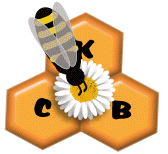Types of Feeders
Types of Feeders
There are different types of feeders you can use with a crownboard (some may need to be adapted depending on feeder) and Eke (an Eke is a small super which sits on the top of the hive, just beneath the roof, and allows space to add a feeder). An Eke may be bought from a supplier, but it can also be made if you take the dimensions of a brood box and halve it (this is approximate).

English Feeder
These will take a large quantity of syrup and are great for “June Gap”.
An English Feeder should not be used in the Winter months as it takes up a lot of space in the hive which can cause the hive to be cooler in winter.

Rapid feeder
Ideal for Autumn but not for Winter. The bees come up from the hive, through the hole in the middle of the feeder. The bees should then travel up from the centre and over a rim and head toward the syrup.

Miller feeder
Bees enter the feeder through a gap in the middle, then up and over the ridges and down to the feed. Click here for a plan (supplied by BeeSource.com) on how to make a traditional wooden Miller feeder.
Frame feeder
These frames are similar to a normal frame, but hollow inside. There is a piece of wood (or other object) that is supposed to float on top so that the bees can sit on it and feed. For some reason, local beekeepers have found that some bees have drowned using this type of feeder. These can usually be found in Nuc boxes if you order a colony of bees.
What to feed and when?
Summer Feeding
When later flowering plants are not producing nectar due to weather or other reasons, beekeepers should ensure their colonies are not starving.
An indication of starvation could be that bees are lethargic, or may even be particularly aggressive.
On checking the frames, there should be plenty of stores on them. If not, you will need to think about feeding.
A sugar syrup solution made up of granulated sugar and water 1:1 (e.g. 6kg to 6 litres of water). The sugar and water should be placed in a pan and heated slowly, continuously stirring. The solution should not boil, but if continuously stirred, the solution will become clear and have a slight yellow colour. It is then ready to leave to cool, then put in a container.
Autumn Feeding
Once the last Supers have been removed (and you may start commencing your Varroa treatment, e.g. Apivar) a mixture of sugar syrup 2:1 water is required to help the bees prepare for Winter.
The advice given from experienced beekeepers is (in September especially) to not feed too much Ambrosia/Sugar Syrup at one time, as you still want the Queen to have space to lay in the brood box. Too much feed may cause workers to fill the frames with feed/stores and the Queen then has no room to lay. It is important she lays to build up the colony strength to see through the Winter.
You can heft the hive to check how much is stored, if it is heavy, the bees may have enough stores, if it is light, it is recommended that you feed.
If the weather is warm enough in September (14 degrees or more), you can usually have a quick check of the frames in the brood box to see if the Queen has space to lay.
The National Bee Unit has a very useful leaflet on feeding (Click here to download).
Winter Feeding
As you do not want to disturb the bees much in winter, it is important to gauge how much food they have stored. To do this you can heft the hive, if it is light, you may want to add a fondant feed which can be bought from bakers or beekeeping equipment suppliers (without additives) or make your own.
The fondant can be placed on the crown board. As bees go into a cluster during the cold weather, it is important that the fondant being provided can be accessed by the bees.
Some beekeepers place the fondant straight onto the crown board, some place on the frames.

Some beekeepers us an adapted crown board for winter feeding. For example, this board has two air vents (as it is the damp, not cold, that kills bees) with a slit that runs across many of the frames (see picture on right). This method should, hopefully, allow bees to reach the fondant depending on where they are clustered.

On top of this you can place a plastic tub with fondant. As you will need to add an eke so that the roof is raised for the fondant, you will need to insulate the area in Winter.

You could use insulation foam and hessian sacking to do this. Remember to cut out space for the air vents. to try and insulate further because an eke (small super) will need to be placed on top of the fondant tub.
Bees should be nice and cosy for the winter.
